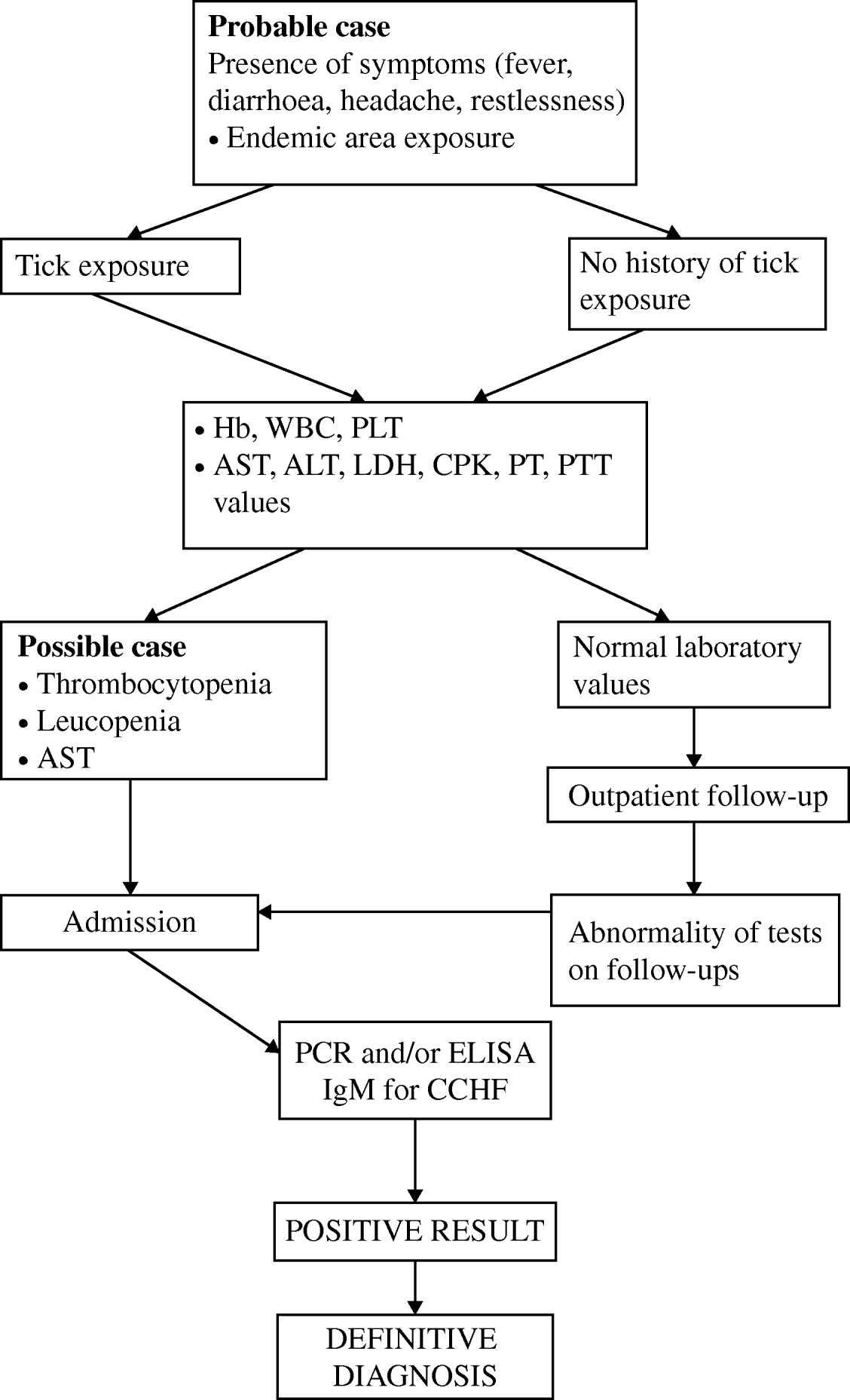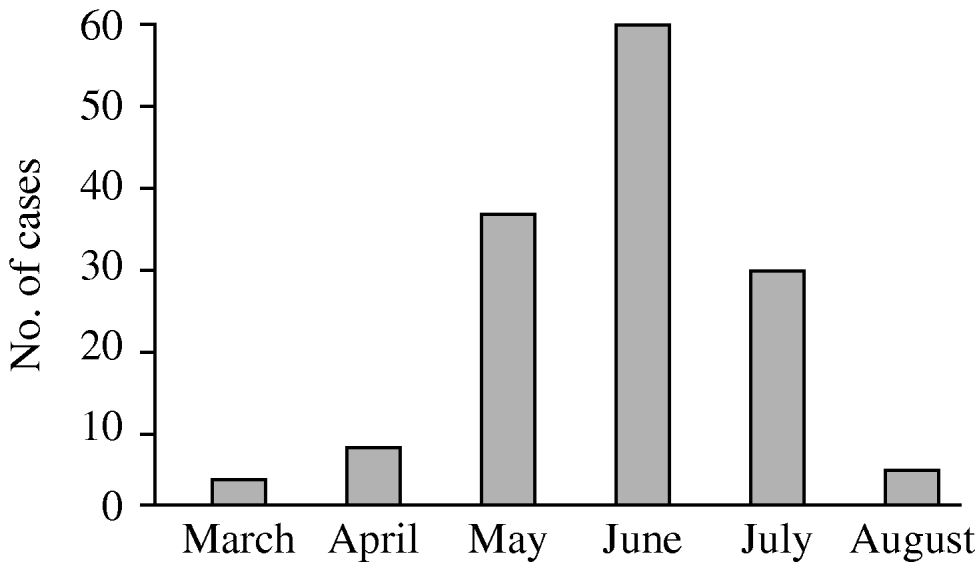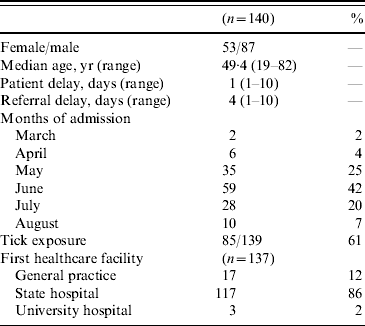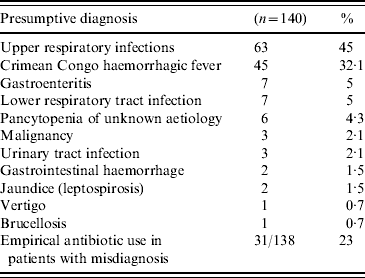INTRODUCTION
Crimean Congo haemorrhagic fever (CCHF) is an emerging viral infection in Turkey. For reasons unknown, the infection emerged in the central and northern regions of Turkey after 2002. This epidemic illness is one of the most dangerous medically significant tick-borne diseases affecting many countries in Africa, Eurasia, Central and Southwest Asia, and the Middle East [Reference Hoogstraal1–Reference Ergonul, Celikbas, Baykam, Eren and Dokuzoguz4]. Humans, who are the only target of the disease, naturally become infected through the bites of ticks which are carried mainly by migratory birds or through exposure to contaminated blood or tissues in nosocomial settings [Reference Whitehouse3].
CCHF is an acute and fatal haemorrhagic infection, characterized by fever, chills, myalgia, arthralgia, nausea, vomiting, headache, back pain, liver dysfunction and haemorrhagic manifestations [Reference Tasdelen Fisgin, Fisgin, Tanyel, Doganci, Tulek, Guler and Duru5]. Many of these clinical manifestations may mimic various other infections since most of them are non-specific. In certain parts of the world, CCHF constitutes an emerging infectious disease with a severe clinical picture and a marked fatality rate. The case fatality rate (CFR) of the disease ranges between 3% and 30% and usually has a direct relationship with the quality of medical care and availability of pre-potent transfusion therapy [Reference Ergonul6]. In Turkey, the first index case of CCHF was diagnosed in 2002 in the Black Sea region, and by 2008 more than 2000 patients (with a 5% CFR) had been confirmed by the Turkish Ministry of Health [7].
MATERIAL AND METHOD
Method of analysis
The method used was a retrospective evaluation of medical records of cases diagnosed as CCHF and seen by staff physicians of the Department of Infectious Diseases and Clinical Microbiology of the Medical Faculty of Ondokuz Mayis University during the period between March 2004 and August 2008. Demographic features (gender, age), tick exposure, time of disease onset, time of first admission, referral period and initial diagnosis, and empirical antibiotic treatment patterns of all confirmed cases were evaluated.
Diagnostic tests
Blood samples were studied for presence of specific IgM antibodies with ELISA and for virus-specific RNA with PCR in Refik Saydam Hygiene Centre, Ankara, which is the national reference laboratory in Turkey. This centre is the only approved institution to perform tests.
Case definitions according to World Health Organization criteria [8]
Suspected case
A patient with sudden onset of illness, having a high-grade fever >38·5°C for >72 h and <10 days, and living especially in the CCHF endemic area, and in those who are in contact with farm animals or other livestock (e.g. shepherds) and agricultural employees. High fever is usually associated with headache and muscle pains, although in some patients those symptoms may be absent in the initial phase.
Probable case
A suspected case with acute history of febrile illness, and
• thrombocytopenia <50 000/mm3and any two of the following:
— petechial or purpuric rash, epistaxis, haematemesis, blood in stool, ecchymosis, gum bleeding, other haemorrhagic symptoms, and
— no known predisposing host factors or haemorrhagic manifestations.
Confirmed case
A probable case with positive diagnosis of CCHF in blood sample:
• confirmation of the presence of IgG and IgM antibodies in serum by ELISA;
• detection of viral nucleic acid in specimen by PCR;
• isolation of the virus.
Patient's delay
Time elapsed from the onset of symptoms until the patient's first contact with the healthcare centre.
Healthcare referral delay
Time elapsed from the patient's first contact with primary and secondary healthcare units; until being admitted to our tertiary-care centre where appropriate treatment facilities are available.
Statistical analysis
Data are given as median range in the statistical analysis: independent-group t tests were used to compare differences between groups when appropriate. Categorical variables were analysed by χ2 test and Fisher's exact test. Differences were considered significant at P <0·05. Statistical analysis of data were performed using SPSS statistical software version 11.0 (SPSS Inc., USA).
RESULT
One hundred and forty adult patients were admitted to our centre during the epidemic period of 2004–2008 with a confirmed diagnosis of CCHF (Fig. 1). All of the cases were confirmed by ELISA IgM and/or PCR for CCHF virus (Fig. 2). There were 53 females and 87 males and the patients' median age was 50 years (range 19–82 years). Median patients' delay was calculated as 1 day; in contrast, referral delay was 4 days. First admissions were usually made to town or county hospitals (n=117/137, 86%), and infrequently to family physicians (n=17/137, 12%). Only three patients (2%) were admitted directly to our medical departments (Emergency Department or Outpatient walk-in) (Table 1). The seasonal admission pattern was evaluated by month, which shows that 42% (59/140) of patients were admitted during June within a 4-year period (Fig. 3). Tick exposure history or tick infestation at time of admission was 61% (85/139), although almost all patients were originating from the endemic region (Table 1).

Fig. 1. Map showing cases with a confirmed diagnosis of Crimean Congo haemorrhagic fever in the endemic region of Turkey, 2004–2008.

Fig. 2. Flow chart for confirmation of a case.

Fig. 3. The seasonal admission pattern for number of Crimean Congo haemorrhagic fever cases (n=140).
Table 1. Demographic characteristics of the patients

The most frequent first diagnosis for patients was: upper respiratory tract infection (n=63, 45%); followed by CCHF (n=45, 32·1%), gastroenteritis (n=7, 5%), lower respiratory tract infection (n=7, 5%), pancytopenia of unknown origin (n=6, 4·3%), urinary tract infection (n=3, 2·1%) and malignancy (n=3, 2·1%) (Table 2). As a result, 95 (68%) of CCHF patients received an initial misdiagnosis and of these, 31/138 (23%) initially had various irrational treatments with broad-spectrum antibiotics.
Table 2. The presumptive diagnosis of the patients at time of referral

Statistical evaluation results for CFRs and average admission time to our centre for the groups of patients that had, or had not, received a CCHF presumptive diagnosis are given in Table 3. According to this evaluation, although the CFR of patients without a correct presumptive diagnosis is higher than the other group, there was no statistically significant result, probably due to the limited number of patients in the groups (patients with initial misdiagnosis had a CFR of 12%, whereas patients who were correctly diagnosed as having CCHF at the outset had a CFR value of 4% (P>0·05).
Table 3. Statistical data of patients who had Crimean Congo haemorrhagic fever (CCHF) presumptive diagnosis vs. misdiagnosis

* Independent groups t tests.
† χ2 tests.
On the other hand there was a statistically significant result when comparing the average time of admission to the referral tertiary centre (patients with initial misdiagnosis had an average referral time of 4·8 days, whereas patients who were correctly diagnosed as having CCHF at the outset had a median of 2·6 days (P=0·000).
DISCUSSION
Although it is unknown why an epidemic of CCHF emerged in Turkey, it is obvious that a greater number of people are affected every year. There have been a number of speculations for possible routes of the spread of disease, the most logical being migratory birds and the tick population boom due to global warming [Reference Ergonul6]. When the disease spreads to a human host, there are many possibilities from asymptomatic, inebriant forms to rapidly fatal infection. Most of the time the infection had three major steps in the pathological process. The first phase starts from contact with the virus and continues with amplification by replication of the virus and spread through the bloodstream, which usually take place within the first few days following onset of symptoms. Most significant clinical findings in this phase are characterized by non-specific ‘flu-like symptoms, e.g. high fever, headache, arthralgia, myalgia, nausea and vomiting. An antiviral drug, which blocks viral replication, such as ribavirin, may play an effective role in preventing the viral amplification in this early phase. The second hypothetical phase of CCHF is characterized by macrophage-activating syndrome, which starts with the decline of viraemia, manifests with pancytopenia and devastates the patient with cytokine storms. In this phase, pro-inflammatory cytokines are released and the coagulation cascade is disrupted in some patients, leading to disseminated intravascular coagulation and massive haemophagocytosis, causing massive haemorrhage and finally death [Reference Ergonul, Celikbas, Baykam, Eren and Dokuzoguz4, Reference Doganci9]. The use of a purely antiviral drug during this phase and beyond would not be beneficial, because immunological mechanisms such as cytokine storm are the major factor in this fatal pathological mechanism [Reference Ergonul10]. Thus far, our 4 years' experience in the epidemic region demonstrate that early ribavirin use has a life-saving potency, although there has been no randomized controlled study to test the effectiveness of ribavirin treatment on CCHF, and there probably will not be due to ethical concerns. This important result is discussed elsewhere [Reference Tasdelen Fisgin, Doganci, Tanyel and Tulek11]. The only limitation of this antiviral treatment modality is the early use of ribavirin to stop viral shedding, which may easily lead to excessive immune responses. On the other hand, there is no dependable clinical or laboratory marker for predicting progression of the disease and clinical outcome. Thus, there is a vital need for an immediate decision to apply antiviral treatment. The present study clearly demonstrates the urgent need for rapid diagnostic tools in the centre of the epidemic region to enable fast differential diagnosis. The Turkish health authority should facilitate the establishment of diagnostic laboratories closer to the central zone of the epidemic, which will allow confirmatory results to reach the attending physician within hours rather than days, or even weeks. Because of the nature of the lifespan of the tick – trans-ovarian and trans-stadial transmission of the virus to new generations – it appears that the epidemic region will remain infected for a longer period than estimated. Therefore, it is essential to stress the importance of continuous medical education (CME) for the staff of primary and secondary (even tertiary) medical care centres and increasing the chances of early recognition of the disease by the physicians in the area. The vital importance of correct and rapid application of the ‘case definition criteria outlined by WHO’ in endemic seasons (March–October in this geographical zone) should be the goal to prevent fatalities.
The authors of this paper had been in the epidemiological field since 2006 implementing CME in order to increase the knowledge of the infection among primary and secondary healthcare providers, receiving strong support from the Governor and the administration of the province of Samsun city. It is believed that this cooperation led to earlier recognition of the disease in the province, however, other neighbouring cities might also benefit from similar widespread CME (Fig. 1). The current study indicates that the mortality rates are significantly smaller in the early-referred patients who received antiviral treatment in the first stage of the disease (average <4·5 days); since the disease, following its natural course, may proceed to the other phases and result in a potentially fatal cytokine storm [Reference Tasdelen Fisgin, Doganci, Tanyel and Tulek11].
In conclusion, our results are very suggestive of highlighting the importance of an initial presumptive diagnosis in increasing patient survival in the epidemic region. Presently, an educational plan is urgently needed and there is also an urgent need for collaborating reference laboratories within or close to the region in order to speed up the correct initial diagnosis from a community healthcare point of view. Another important result of the study is the observation of irrational widespread use of antibiotics in any disease with high fever in the region. This striking unnecessary antibiotic use in CCHF patients also demonstrates an urgent need of CME on this subject as a secondary result.
DECLARATION OF INTEREST
None.








